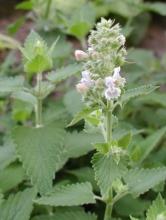

Catnip
Nepeta cataria
This member of the Mint family, the Labiatae, is quite a vigorous grower, and spreads its seeds readily. Its aromatic leaves and flowers are famous for attracting cats and kittens and driving them a bit wild; it seems, however, that they prefer the aroma of the dried herb to that of the fresh. We harvest the leaves before the flowers set, usually in early June.
Elemental associations: Water
Phytochemistry: Volatile and essential oils, tannins (D. Hoffmann)
Actions: Anti-catarrhal, hypnotic, diaphoretic, antiviral
Specific systems: Upper respiratory, nervous
The first clue to the action of Catnip comes from observing cats, who are quite intoxicated by it (usually). In humans it is much less stimulating, and in fact has more of a sedative and calming action, but can still be intoxicating to those of more sensitive constitutions (be alert for this). It can be used along with other herbs in a ritual / journeying context as well.
During a cold or flu, this herb can really shine, loosening congestion in the sinuses and promoting a healthy sweat. Added to a warm brew with other diaphoretic herbs, it can really help manage the symptoms of these winter ailments. In addition, is has recently earned a reputation as quite the virus-fighter: another reason to include it in your cold/flu tea formula.
All the above qualities (including the calming effect) make it a great remedy for sick children.
A final note: recently, the volatile oils of Catnip were isolated (hard to do – they are not very abundant) and found to be more potent than DEET (a carcinogen) for repelling mosquitoes. I have rubbed the fresh plant on myself and carried a few sprigs around in my hair, and even this seemed to work well against the pesky critters, if not very long (only about 30 minutes).
Indications: Upper respiratory infection, nervousness, trance work / journeying, cats
Contraindications: Pregnancy
Preparation/Dosage: An excellent hot infusion is prepared with 3 TBS of the dried herb in a quart of water. The tincture can also be used, using the fresh leaves at 40% alcohol, 1:3 to 1:5; or the dry leaves at 33% alcohol, 1:4. Take ¼ to ½ dropper 3-5 times daily (higher and more frequent doses are for respiratory infections). The dry herb can also be added to smoking blends and incenses.
